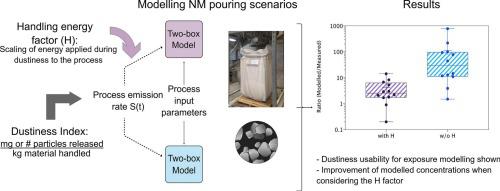NanoImpact ( IF 4.9 ) Pub Date : 2024-01-14 , DOI: 10.1016/j.impact.2024.100493 Carla Ribalta , Alexander C.Ø. Jensen , Neeraj Shandilya , Camilla Delpivo , Keld A. Jensen , Ana Sofia Fonseca

|
The use of modelling tools in the occupational hygiene community has increased in the last years to comply with the different existing regulations. However, limitations still exist mainly due to the difficulty to obtain certain key parameters such as the emission rate, which in the case of powder handling can be estimated using the dustiness index (DI). The goal of this work is to explore the applicability and usability of the DI for emission source characterization and occupational exposure prediction to particles during nanomaterial powder handling. Modelling of occupational exposure concentrations of 13 case scenarios was performed using a two-box model as well as three nano-specific tools (Stoffenmanager nano, NanoSafer and GUIDEnano). The improvement of modelling performance by using a derived handling energy factor (H) was explored. Results show the usability of the DI for emission source characterization and respirable mass exposure modelling of powder handling scenarios of nanomaterials. A clear improvement in modelling outcome was obtained when using derived quartile-3 H factors with, 1) Pearson correlations of 0.88 vs. 0.52 (not using H), and 2) ratio of modelled/measured concentrations ranging from 0.9 to 10 in 75% cases vs. 16.7% of the cases when not using H. Particle number concentrations were generally underpredicted. Using the most conservative H values, predictions with ratios modelled/measured concentrations of 0.4–3.6 were obtained.
中文翻译:

使用灰尘指数与处理能量因子相结合进行纳米材料的暴露建模
近年来,为了遵守不同的现有法规,职业卫生领域建模工具的使用有所增加。然而,限制仍然存在,主要是由于难以获得某些关键参数,例如排放率,在粉末处理的情况下,可以使用含尘指数(DI)来估计排放率。这项工作的目标是探索 DI 在纳米材料粉末处理过程中对排放源表征和颗粒职业暴露预测的适用性和可用性。使用两盒模型以及三个纳米专用工具(Stoffenmanager nano、NanoSafer 和 GUIDEnano)对 13 个案例场景的职业暴露浓度进行了建模。探索了通过使用导出的处理能量因子 (H) 来提高建模性能。结果显示了 DI 在纳米材料粉末处理场景的排放源表征和可呼吸质量暴露建模方面的可用性。当使用派生的四分位数 3 H 因子时,建模结果得到明显改善,1) 皮尔逊相关性为 0.88 与 0.52(不使用 H),2) 建模/测量浓度比率为 75%,范围为 0.9 至 10病例数对比不使用 H 时的病例数为 16.7%。颗粒数浓度通常被低估。使用最保守的 H 值,获得了模型浓度/测量浓度比率为 0.4–3.6 的预测。



























 京公网安备 11010802027423号
京公网安备 11010802027423号